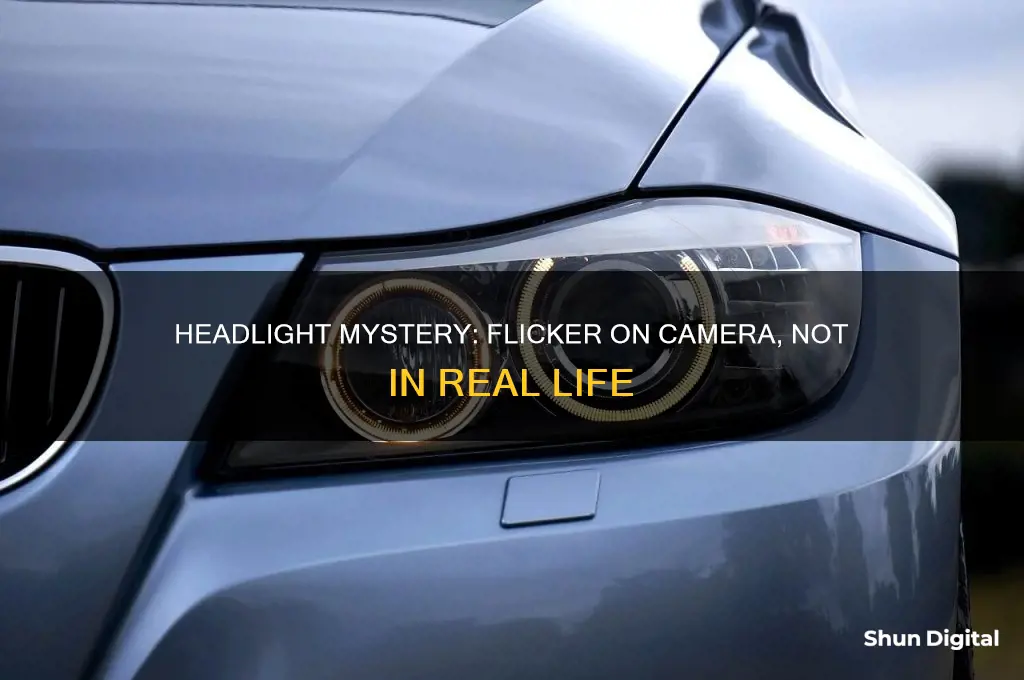
Car headlights may appear to flicker on camera due to a phenomenon known as the strobe effect, which is caused by the rapid switching of LED lights between their on and off states. This flickering typically occurs at a frequency that is imperceptible to the human eye, but it becomes visible when captured by a camera. The frame rate of the camera can interfere with the frequency of the LED lights, resulting in a noticeable strobe effect in the recorded video or image. This effect can be mitigated by adjusting the camera's frame rate and shutter speed to match the frequency of the LED lights.
| Characteristics | Values |
|---|---|
| Reason for flickering | The frame rate of the camera is faster than the speed at which the diodes of the lights alternate between on and off. |
| The camera captures the light at a similar rate to the frequency of the light, causing interference. | |
| The camera's shutter speed is not compatible with the light's frequency. | |
| The light source is connected to an alternating current instead of a direct current. | |
| Dimming methods, such as Pulse Width Modulation (PWM), are used to create special effects in photography. | |
| The frame rate of the camera matches the rotational speed of the object being filmed, causing an illusion of stationary motion. | |
| How to fix flickering | Choose a compatible shutter speed with the corresponding frame rate. |
| Adjust the shutter speed to the suitable rate for the given frame rate and power frequency. | |
| Use a large light source to reduce the time for the filament to cool between power cycles. | |
| Use alternative dimming setups instead of PWM. | |
| Use a stable light source, such as LED lights connected to a DC supply. | |
| Turn on in-camera anti-flicker settings and set the correct frequency. |
What You'll Learn

Cameras capture images at a similar rate to LED flicker
LED lights flicker because they operate on alternating current (AC), where electrons in the current move in cycles in and out of the circuit. In one hertz or cycle, the bulb turns off two times since the electron moves in and out. This is too fast for the human eye to catch, but not for cameras.
The human eye perceives things that are flickering very fast as constant. If the flicker is below the flicker fusion threshold, we can't tell the flashes apart. However, cameras do not have this threshold. The exposure time of video is usually around 1/60th of a second, which is enough to distinguish the flashes.
When the frame rate of the camera and the LED light don't match, the flickering becomes obvious on the camera screen. This is because the camera's shutter speed is faster than the speed of a flickering LED light. When the LED light on the screen flickers black instantly, the camera has captured the light while it was off in its cycle.
The flicker happens because the camera and the LED lights are on different frame rates. This is why car headlights, which are often LED, appear to be flashing when recorded on a cellphone camera. The camera captures the light when it is off in its cycle, creating a flickering effect.
Easy Guide: Setting Up a Car Review Camera
You may want to see also

Cameras have faster shutter speeds than the human eye
Car headlights may appear to flicker on camera due to the faster shutter speed of the camera compared to the human eye. The human eye cannot detect the rapid flickering of LED lights, which is often about 50 times a second. This flickering is a method of regulating brightness, known as Pulse Width Modulation (PWM). While our eyes cannot perceive this, cameras can, and the interference between the two creates a flickering effect.
The shutter speed of a camera plays a crucial role in photography, allowing photographers to control the brightness of their images and create various visual effects. A fast shutter speed results in a shorter exposure, capturing a crisp, freeze-frame image. This is particularly useful for sports photography or capturing fast-moving subjects, as it eliminates motion blur. On the other hand, a slow shutter speed provides a longer exposure, allowing more light to enter the lens and creating a motion blur effect. This technique is often used in advertisements to convey a sense of speed or in landscape photography to capture the motion of rivers and waterfalls.
The human eye, however, operates differently from a camera. Our eyes have a slower response to changes in light intensity, and we perceive light through a process called visual persistence. This means that our eyes retain an image for a brief moment after the light source has stopped stimulating our retina. This phenomenon allows us to perceive continuous motion in movies and prevents us from seeing the individual frames.
In summary, the human eye and camera have different ways of perceiving light. The faster shutter speed of a camera can capture the rapid flickering of LED lights, which is beyond the perception of the human eye. This difference in perception results in the flickering effect observed in car headlights on camera.
Understanding PIR Mode on Trail Cameras: How Does It Work?
You may want to see also

Cameras can capture the effect of LEDs flashing on and off
LED lights, by default, turn on and off very quickly—too quickly for the human eye to detect. They are designed to flicker to regulate their brightness and this is known as Pulse Width Modulation or PWM. This is a common method of controlling the brightness of LED lighting.
The frame rate of a camera is often similar to the rate at which LEDs flicker, so sometimes you can see the flicker as they interfere with each other. The camera captures the flashing of the LED headlights, which are on and off in a wave form. The LED is flickering on and off, but too fast for human eyes to notice. However, the camera picks it up and it appears to be flashing on screen.
This is similar to when a film of a helicopter is taken and the blades seem to be stationary and not rotating. This is because the frame rate of the camera matches the rotational speed of the blades. When they match, the camera only captures an image every time the blade is in the same place, giving the illusion that it is not rotating.
The strobe effect is a phenomenon where a moving subject in a video appears to be momentarily frozen in place due to rapid, intense light flashes. This can be created on purpose, but the flickering lights seen on camera are usually incidental.
The flickering happens because the frame rate speed of the camera is faster than the speed at which the diodes of the lights alternate between on and off. In the US, lights generally operate at a 60Hz standard, switching on and off 60 times in one second. A camera with a high video frame rate or shutter speed will capture this and it will appear to flicker.
The strobe effect can be reduced by adjusting the frame speed and shutter speed to multiples of the frequency of the alternating current.
Ohio Camera Speeding Tickets: Do You Have to Pay?
You may want to see also

LED headlights use Pulse Width Modulation
PWM is used in LED headlights to regulate brightness and increase bulb life. It allows for variable brightness by altering the duration of the "on" pulse relative to the "off" pulse, known as the duty cycle. This method of brightness control is more efficient and cost-effective than using a large resistor to vary the current. It also generates less heat, as the LED can cool down during the "off" pulse.
The frequency of PWM in LED headlights typically ranges from 50 times per second to several thousand times per second. While this is faster than the human eye can detect, it interferes with the frame rate of a camera, resulting in the flickering effect.
PWM also offers other benefits for automotive lighting. It ensures that bulbs receive the intended voltage, allowing for a soft startup and filtering out line spikes. This helps to prolong bulb life and maintain consistent lighting performance. Additionally, PWM enables tricks like using a single-filament bulb for both bright and dim functions, such as stop/tail or turn/park lights.
While PWM is commonly used in LED headlights, it can cause issues with flickering when installing HID or LED kits in vehicles equipped with PWM technology. This is because HID and LED kits require constant power, and the pulsed voltage of PWM can cause the lights to flicker. However, there are PWM fixes available that provide a seamless lighting experience by ensuring constant power delivery.
The Magic of Camera Zoom: Capturing Far-Away Objects
You may want to see also

The frame rate of a camera can slow down the pulsing of an LED headlight
LED headlights in cars often have variable brightness, which is controlled by using Pulse Width Modulation (PWM). This means that the power fed to the LED is in pulses, or a waveform. At low brightness, the LED is actually flickering on and off, but too fast for the human eye to notice. However, when viewed through a camera lens, the flickering becomes more obvious and apparent because the frames per second (FPS) recording of the camera is not aligned with the frequency of electricity.
The mismatch between the LED light's frequency and the camera's frame rate can be mitigated by adjusting the camera's shutter speed to match the frequency of the power supply. For example, in the US, where the electricity operates on 60Hz, the shutter speed can be adjusted to intervals divisible by 60 (e.g. 1/60, 1/120). This will decrease the flickering effect.
Copying Camera Raw Selections: A Step-by-Step Guide
You may want to see also
Frequently asked questions
Car headlights flicker on camera due to the rapid switching of LEDs between their on and off states. This is too fast for the human eye to catch, but a camera can capture it.
The strobe effect is when a moving subject in a video appears to be momentarily frozen in place due to rapid, intense light flashes. This is a similar but higher-frequency effect to flickering.
You can adjust the frame speed and shutter speed of your camera to multiples of the frequency of the AC current.
Pulse Width Modulation is a common method of controlling the brightness of LED lighting. It involves breaking the continuous energy input into discrete bundles, resulting in flickering.







